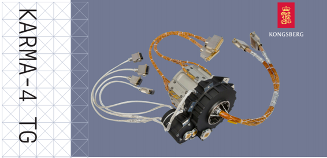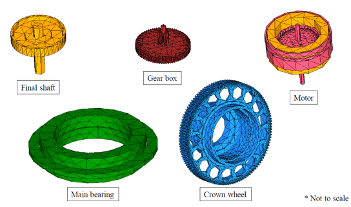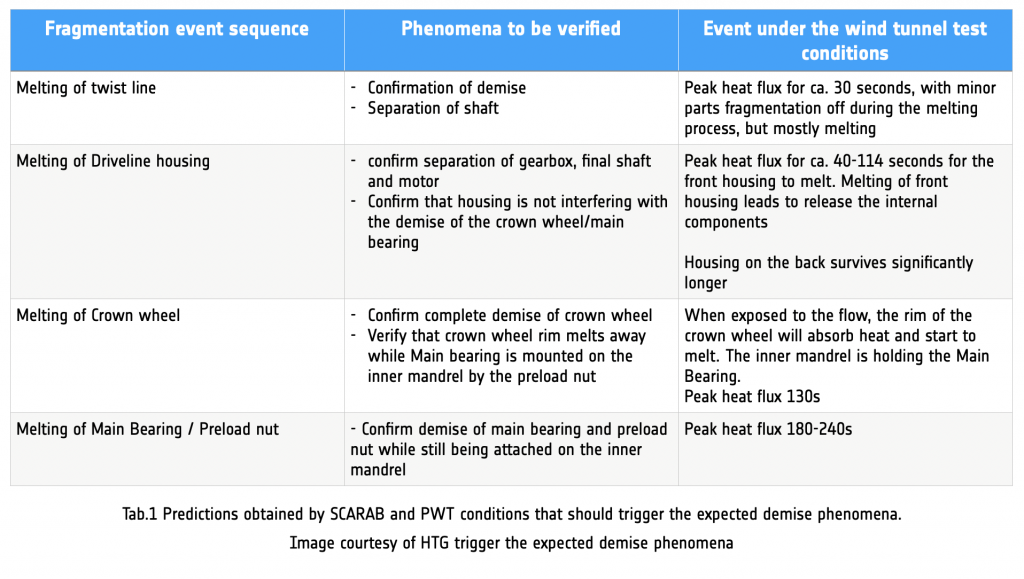When a spacecraft reenters from space in the Earth’s atmosphere, operators are required to minimise the risk of causing casualties. In particular, to perform a so-called uncontrolled reentry, an operator has to prove that the on-ground casualty risk posed by its satellite is lower than 1 in 10 000.
Therefore, a thorough analysis is performed to assess how the spacecraft will fragment and ablate during reentry in order to estimate the size and number of fragments that could reach the ground. In recent years, multi-disciplinary assessments identified the critical equipment in terms of demisability. Various factors, such as the materials used and shielding of the spacecraft, contribute to this criticality. For example Solar Array Driving Mechanisms (SADM) were identified as critical because they contained critical materials such as steel and titanium.
This is why in 2020, Kongsberg Defence & Aerospace (KDA) started an investigation supported by ESA, Hyperschall Technologie Göttingen GmbH (HTG) and the German Aerospace Center (DLR), to develop a detailed model of a SADM on one of the reentry simulation software tools, to assess its demisability depending on the altitude where the unit is separated from the spacecraft. They also planned to propose changes to the SADM design that could enhance its demisability. Then, an on-ground test campaign was conducted to validate the models.
The unit that they chose to investigate is the KARMA-4 TG (Kongsberg Adaptive Rotational Mechanism Assembly), a fully qualified Kongsberg Third Generation SADM, envisaged for LEO and GEO usage.

Modelling
The modelling of the SADM was first done in SCARAB by HTG. A SADM is made up of many sub-components which had to be modelled separately, as show in Fig.2. Analysing the demise phenomenology of the SADM in the simulations allowed to identify each step that needed to be confirmed during the testing phase (e.g. subsequent melting or separation of two sub-components).

The detailed baseline model for KARMA-4 TG is simulated to be demisable with a 5% significance level at 76 km release altitude. Moreover, some iterations were performed to increase confidence in this result, such as exploiting different reference trajectories or assessing the impact of modelling simplifications on the main bearing. Such simplifications were seen to improve slightly the most probable demise altitude. Another interesting investigation was to use the ESTIMATE material database instead of the SCARAB database, because it resulted in a demise altitude of 80 km with 5% significance level.
To enhance the SADM demise, KDA proposed to change the material of the screws to one with a lower melting temperature (e.g. aluminium). This would allow for an earlier fragmentation of the SADM into its sub-components. The benefit of such a design was simulated by triggering this fragmentation event at a lower temperature. This lowered the minimum release altitude to 70km.
Test predictions
According to DIVE, the ESA Guidelines for Analysing and Testing the Demise of Man Made Space Objects During Re-entry, it is necessary to produce predictions for the demise phenomenology prior to the test. To do so, the SCARAB model was modified, in accordance with the test sample, to be able to first predict and later recreate the test. Using the heat flux steps provided by DLR, HTG was able to simulate the test performed in the plasma wind tunnel.
This allowed them to produce an expected sequence of events and to determine the PWT test conditions that should allow to observe the demise phenomenon that one wants to verify (see Tab.1).

Testing
A simplified KARMA-4 model, with lower fidelity, was manufactured as a test sample for the demisability test. The test campaign was conducted in the L3K wind tunnel facility of DLR. The first test was performed on the full SADM model, including the housing. The sample used for the second test was an assembly of the inner mandrel and crown wheel, main bearing and preload nut.
Fig.3 Image of the sample during the test. Image courtesy of DLR
The main conclusion was that the demise phenomenology observed in test matched quite well the test predictions obtained through the simulations. However, due to some uncertainties in certain parameters, such as material properties and heat flux, the models needed some tweaking to match the tests and to be verified. This will be further detailed in the Test correlation section.
Some considerations that were done after the test campaign were that samples should always be as representative as possible: all simplifications must be considered carefully and justified by (demise testing) experience. In particular, the material can change the demise process, and whenever possible it should therefore be the same. Surface properties could also be impactful for the demise and shall be reproduced as correctly as possible.
Test correlation
After the test campaign, HTG correlated the test results with the simulations.
To rebuild the tests, some parameters in the simulations had to be adapted to match the test observations and demise timeline. In particular, it was necessary to take into account material properties uncertainties and in accordance with the values provided by the ESA ESTIMATE database, it was required to modify the material properties to their lowest allowed uncertainties range (following the ESA DIVE guidelines). In addition, to overcome the tools limitations on the simulations of the local heat flux effects, a slight increase of the heat flux was proposed, but it is generally not recommended.
To conclude, the tests show a good demisability properties of the samples and the simulations resulted to be slightly conservative with respect to the tests. However this result should be seen taking into account the uncertainties in simulations and tests, as well as the simplifications in the sample characteristics with respect to the flight hardware.

The final task of this activity was for HTG to build a DRAMA model of the SADM, that will surely be the starting point to create an accurate model available to the users of the ESA DRAMA software in the future. The simplified model correlation was successfully achieved and it demonstrated the benefits of the implementation of the ESA DIVE guidelines. In particular the DIVE logic was successfully applied and an improvement of the document are expected in the near future.

Conclusions
This activity was carried out successfully, closely following the DIVE guidelines to ensure a standard approach to demise verification. Future studies should investigate higher fidelity test samples.
Lastly, due to the flexible nature of wires and cables, the harness has been excluded from the study, but it would be valuable to assess the impacts of harnesses on the overall demise phenomenology.
Related links
- A new method to reduce the casualty risks of space debris during re-entry
- Clean space webinar on design for demise
- Spacecraft breaking up is hard to do
- Burning up a magnetorquer in a plasma wind tunnel
This post has been prepared in collaboration with Benedetta Cattani, system engineer intern at ESA in 2020-2021.







Discussion: 4 comments
what is the future of HTG and KDA development of other reentry simulation software tools?
How are these investigations funded?
Dear Hiram,
The SCARAB tool is being further developed and refined by HTG under ESA funding. ESA is currently also exploring the options to fund the next stage of the Demisable SADM development.
Have a lovely day,
Jessica
I was impressed by the video. DLR I did not know there was such a thing called a plasma
Wind tunnel. My engineering instructor was equally impressed that I was the only student to answer a test. The answer was
PLASMA!
Good ! very impressive for us . What’s your future task?